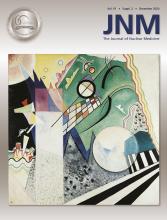As medical researchers, we hope that our scholarship will have lasting and positive effects on patient care. Perhaps in the night we dream of dramatic impacts that could result from our work. It is hard to imagine, however, that Don Wieland and colleagues could have foreseen the enduring benefits and legacy of their work on a myriad of patients with various benign and malignant conditions (1). Indeed, in the four decades since their seminal publication, there have been over 4,500 articles on metaiodobenzylguanidine (MIBG), the drug first described in JNM in 1980. Furthermore, since its discovery there have been more papers on MIBG in every decade than in the one before it. This is a discovery that continues to grow and foment investigation. Of course, Don was passionate about forests and loved planting trees whenever he could, so it is quite possible he anticipated what the future could hold when the starting product is so carefully nurtured. We are gratified at the opportunity to comment on this paper, given the huge impact MIBG has had on our careers, as well as the honor and privilege it was to have worked with some of the coauthors at various points in our careers.
We have all been taught the scientific method, and this article is a beautiful tutorial. The authors observed a problem: the adrenal medulla is functionally distinct from the cortex and requires a dedicated imaging agent. Interestingly, they mention the already-available adrenal cortical imaging agents that have been consigned to history whereas their discovery remains ever more relevant today. They stated their goal and a hypothesis and then tested it with careful objectivity. The method worked, and the end result was both robust and rigorous.
In addition to the scientific method in general, the authors also had a keen understanding of their specific field. Radiopharmaceutical development poses considerable challenges, and the successful radiochemist must also be an anatomist, physiologist, and physicist. Here, they have developed a drug with an uptake ratio of nearly 1,000:1 in the adrenal medulla compared with the liver, but because of the tiny size of the adrenal gland, adjacent to the much larger liver, it remained difficult to detect any adrenal uptake above background liver level. However, their chemistry was good and their reasoning sound. The relatively crude “unclear medicine” images available in 1980 would be supplanted by the exquisitely sensitive devices we have today, resulting in ever greater utility for their discovery. Indeed, 40 years after their discovery, MIBG imaging plays a central role in response assessment in neuroblastoma (2).
Careful attention to detail for various applications is also of critical importance. Although iodobenzylguanidine labeled in either the para or the meta position has excellent affinity, MIBG has the superior stability in vivo, showing the importance of the structure–function relationship—an important focus of the lab’s. Although potentially less important for diagnostic uses, this relationship is of critical importance for radiotherapeutic uses, for which a prolonged retention time at sites of disease is critical for a beneficial therapeutic ratio. Thus, MIBG is a successful therapeutic that plays a critical role in children with relapsed or refractory neuroblastoma, and it recently became the first treatment ever approved by the Food and Drug Administration for advanced pheochromocytoma and paraganglioma (3,4).
Interestingly, the authors envisioned the use of their agent for cardiac imaging, given the rich adrenergic innervation of the myocardium. They were seemingly discouraged by a low uptake ratio in the heart compared with that in the lungs and liver. However, their initial characterization was correct: MIBG in the myocardium is a measure of adrenergic innervation. It would be some time, however, before the observation was made that MIBG can be used to detect the relative lack of myocardial uptake. Specifically, a low heart-to-mediastinum ratio predicts a higher event rate in patients with heart failure (5). And so it is that the authors’ discovery has impacted the lives of thousands of patients with congestive heart failure because the science was sound and robust even if the specific use had not yet been discovered.
Shortly after the discovery of MIBG, efforts were started to improve on it both diagnostically and therapeutically. For example, PET agents, both analogs and other substrates for the norepinephrine transporter, have been developed (6). Indeed, even today, fluorinated analogs for PET imaging are in clinical trials, and astatinated analogs are nearing clinical trials for α-particle therapy. In the coming years, these may finally supplant MIBG for diagnostic and therapeutic uses. However, for the time being, MIBG—exactly as described in 1980—remains the gold standard. Every day, patients around the world and across the age spectrum benefit from this wonderful drug so concisely and elegantly reported in JNM 40 years ago.
DISCLOSURE
No potential conflict of interest relevant to this article was reported.
- © 2020 by the Society of Nuclear Medicine and Molecular Imaging.
REFERENCES
- Received for publication June 10, 2020.
- Accepted for publication June 26, 2020.







